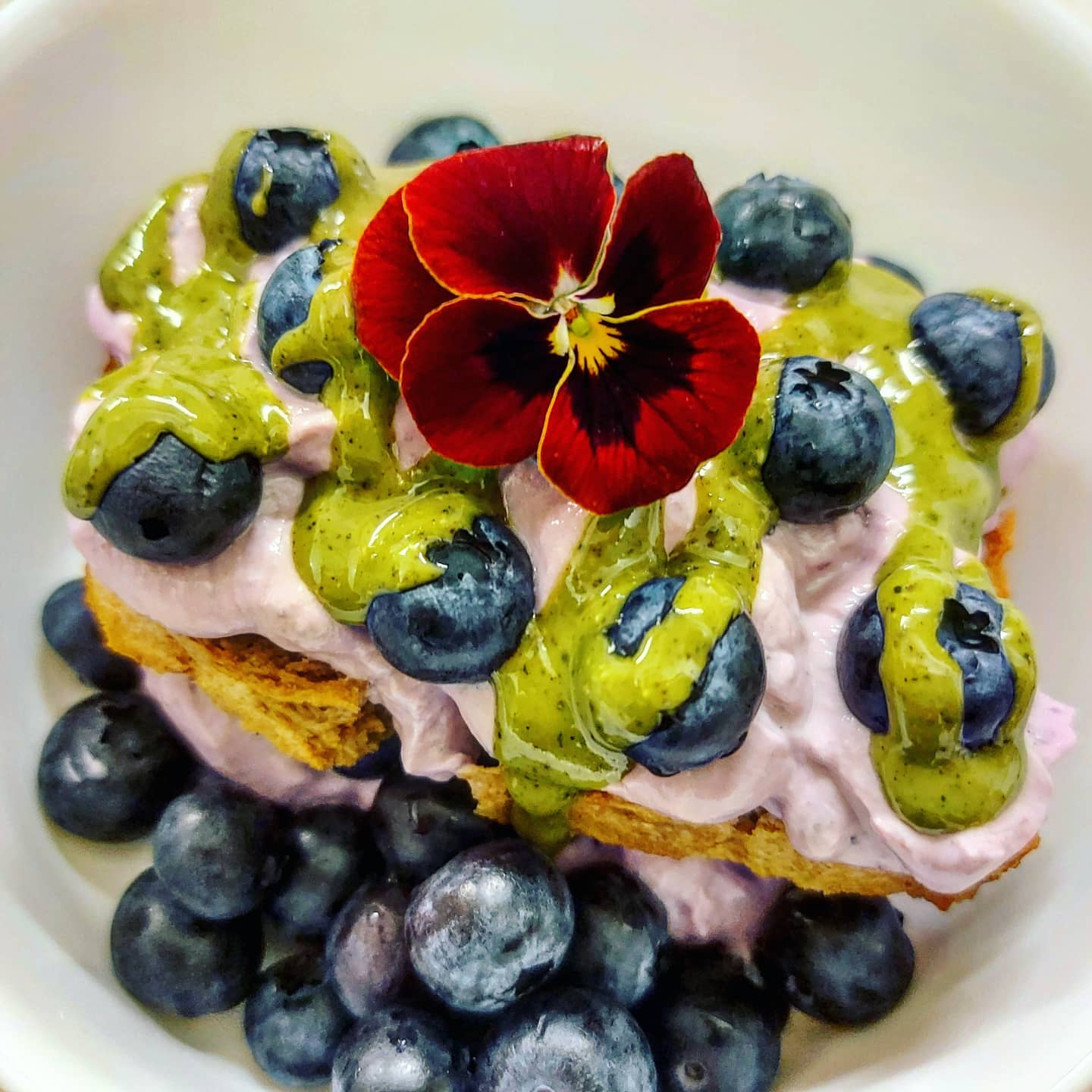Korean Vegetarian Bibimbap (High-Protein Recipe!)
HurryTheFoodUp is reader-powered. If you click through using links on our site we may earn a small commission at no cost to you.
If you’re looking for a meal idea that’s as exciting to look at as it is to eat then you will love our vegetarian bibimbap bowl!
It’s got a great combination of delicious veg topped with yummy tofu and eggs for protein, what more could you need for the perfect weeknight meal?

Ingredients
Take a closer look at the bibimbap ingredients,
Rice
In this classic Korean dish, we’re using sushi rice to keep the dish authentic to its south Asian roots. The sticky consistency of this short grain rice makes it a great base for everything else, quite literally a bed of rice!
Veggies
Grate the carrot, slice the cucumber, and cut the zucchini into sticks – making them all the easier to pick up with chopsticks if you’re feeling inclined.
You’re going to cook some of these veggies and some you’re going to be keeping raw. This give a great way to compliment the rice, with a bit of crunch too!
Protein
Firstly for this easy bibimbap recipe, you’ll be adding tofu for protein, a great Asian ingredient that you can find in most grocery stores.
But if that’s not enough for you, you can add a perfect fried egg on top for a second boost of protein-packed power!
Seasoning and Sauces
To give it that authentic taste of Korea you’ll be using great Asian flavors.
You’ll be cooking in sesame oil, and combining honey, rice vinegar, and soy sauce to make a yummy dressing with an added kick from sriracha!
To Finish
Once all the veggies and protein are added you can pop on some kimchi if you like and a drizzle of soy sauce to taste – so delish!
Part of the fun about this rice dish is you can get really creative, layering your toppings on top of the rice in any Instagram-worthy way you fancy!
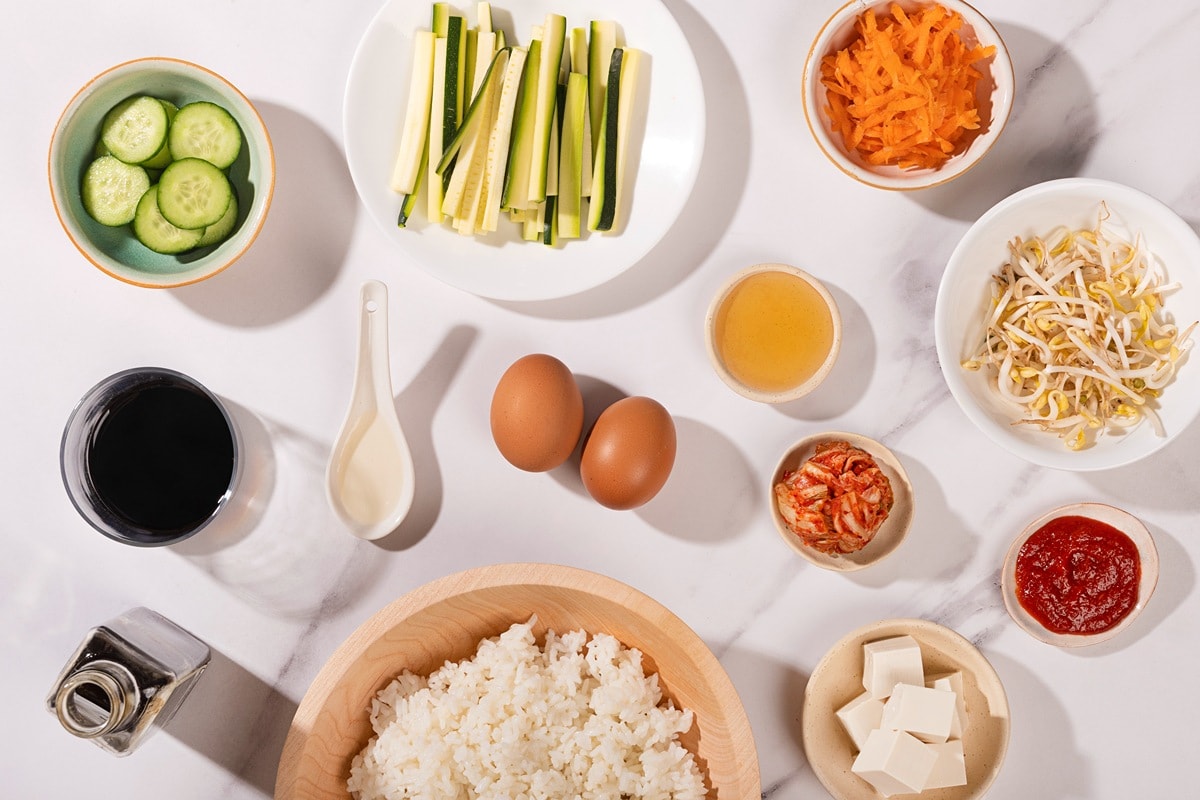
Health Benefits
This vegetarian Bibimbap contains 462 calories per serving.
Here’s a quick overview of 1 serving:
- Calories 462kcal
- Carbs 60g
- Fat 14g
- Protein 25g
This is a vegetarian, gluten-free, and dairy-free Korean bibimbap recipe. At under 500 calories, it’s a great dish when you’re counting the calories, and it provides a whopping 25 grams of protein!
Zucchini, cucumbers, and carrots all have a great number of nutrients in them. They’re also all a great source of dietary fiber and antioxidants. Carrots are especially rich in vitamin A, just like zucchinis!
Protein from ingredients like tofu and eggs will do wonders to help you stay full in between meals so you’re not snack hunting and wasting those precious calories.
For more muscle-making high-protein meal ideas like this one why not download your FREE 7-day high-protein meal plan?
Or if you’d like more weight-loss inspiration we have a great meal plan for weight-loss just for you which is free to download too!
As the national food of South Korea kimchi works really well in this recipe. The health benefits of kimchi are great!
Its fermented goodness is packed with vitamins, especially vitamin K, which is essential in helping your blood clot!
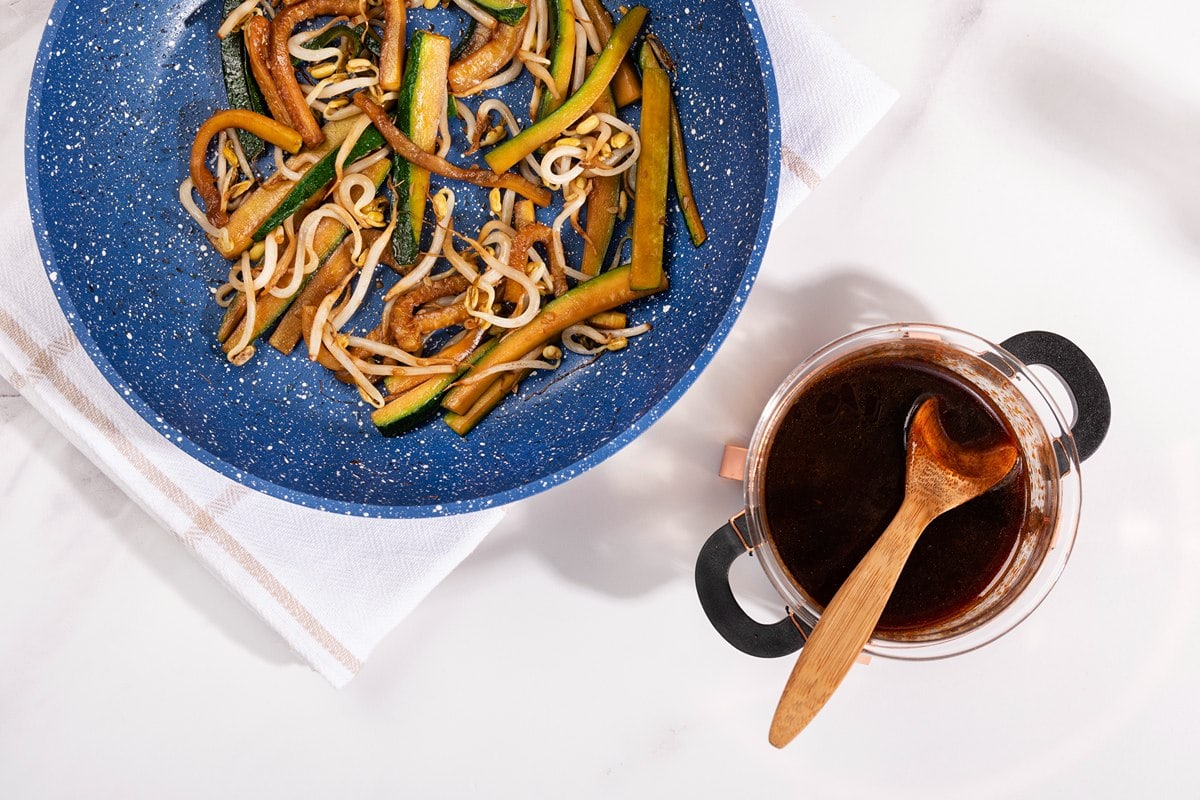
How To Make Bibimbap
Here’s a quick overview of how to make this delicious Korean rice bowl:
- Cook the rice
- Cube the tofu
- Grate the carrot
- Slice the cucumber
- Cut the zucchini into sticks
- In a small bowl mix the honey, rice vinegar, sesame oil, cold water, soy sauce, and sriracha
- Fry the eggs, sunny side up of course, then remove and fry off the zucchini
- Add the mung bean sprouts and some soy sauce to the pan
- In a medium bowl put a single layer of cooked rice in a bowl and add a variety of toppings
- Drizzle over more sauce if needed
(For all the extra details for this bibimbap bowl recipe see our below)
Vegetarian Bibimbap FAQs
What is bibimbap sauce made of?
As we’re using in our recipe, traditional flavors used in Asian cuisines such as rice vinegar, sesame oil, and soy sauce can often be found in bibimbap sauce.
Is bibimbap healthy?
Yes, bibimbap is a great healthy choice. It’s full of nutritious veg, healthy carbs, and protein that will keep you feeling fuller for longer.
What goes well with bibimbap?
Like any good buddha bowl, there are so many different things that go well with bibimbap. The combination of bibimbap toppings really is up to you.
Why not experiment with a whole rainbow of vegetables or protein options?
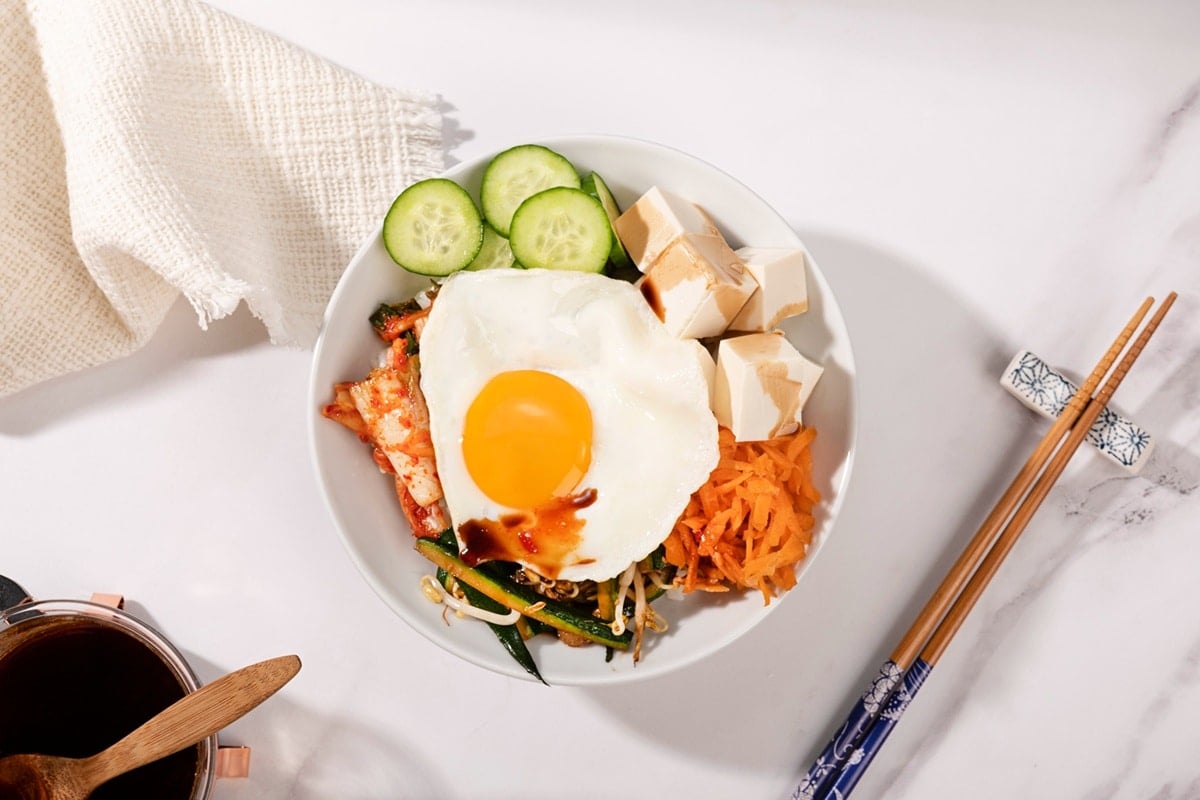
Recipe Variations and Alternatives
Obviously, the first change you can make here is to remove the eggs and go vegan, it’s such an easy alteration to make a great vegan bibimbap.
You could even add more tofu to up your protein intake in lieu of the eggs.
You could change out the vegetables from the original recipe if you prefer something different, maybe shiitake mushrooms instead of zucchini.
Or perhaps shredded red cabbage instead of carrot. Really any leftover vegetables will do.
If you’re really into your Korean cooking and you’re looking for an even more authentic flavor, you could add some Gochujang (chili pepper paste), or Doenjang (soybean paste) to your bibimbap sauce.
Love sesame seeds? Why not sprinkle some on top?
More Recipes
Check out more of our favorite recipes:
Eggs for a hangover! Baked Eggs in Spinach and Tomato
Yummy sesame tofu – Vegan Poke Bowl
Korean inspired – Vegan Lettuce Wraps
Super easy – Vegetable Frittata
Easy, creamy, dreamy – Zucchini Soup
More Information
If you love to meal prep then this is a great one to make. Get ahead for lunches or even weeknight dinner by prepping the sticky rice and all the different vegetables.
Keep it all in an airtight container in the fridge until you’re ready for the eggs (or not if you prefer!).
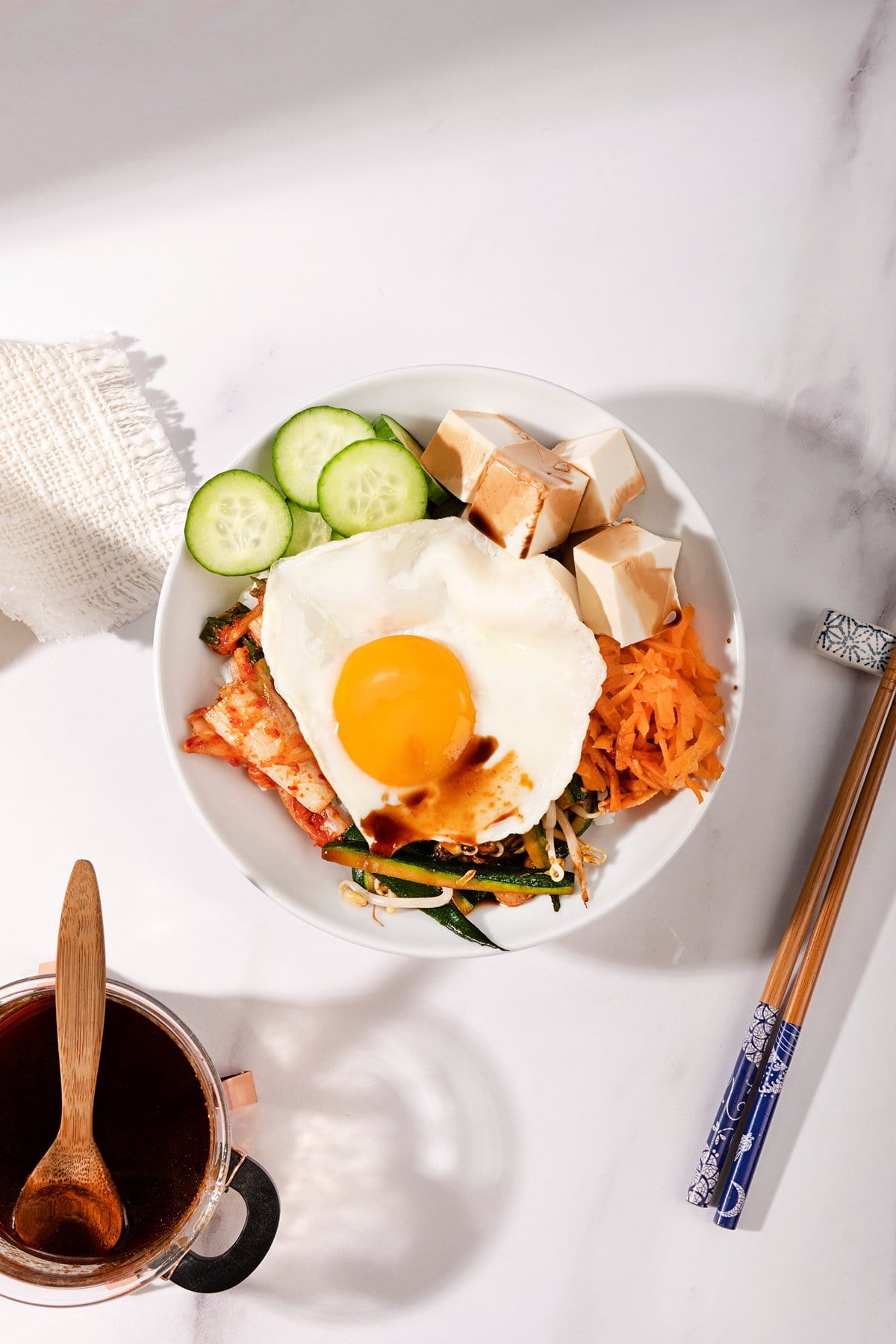
Korean Vegetarian Bibimbap (High-Protein Recipe!)
A colorful bowl of delicious veg and golden eggs, what’s not to love about this vegetarian Bibimbap?
- Cook sushi rice according to package instructions. Once it’s ready, add ½ tsp of sesame oil and mix.
½ cup sushi rice, 2 tsp sesame oil
- Cut tofu into 2 cm/1 inch cubes.
8 oz tofu
- Grate the carrot.
1 small carrot
- Cut cucumber into slices.
1 small cucumber
- Cut the zucchini into sticks.
1 small zucchini
- In a small bowl add sriracha, honey, rice vinegar, ½ tsp of sesame oil, 1 tsp water and 1 tbsp soy sauce. Mix until combined.
2 tbsp sriracha, 1 tbsp honey, ½ tsp rice vinegar, 2 tsp sesame oil
- In a small non-stick pan, fry the eggs with 1 tsp of sesame oil. Remove eggs and add zucchini sticks to the same pan. Cook until they soften, about 1-2 minutes. Add the bean sprouts, 1 ½ tbsp of soy sauce, plus a pinch of salt. Cook until the bean sprouts are tender and translucent, about 1 minute.
2 tsp sesame oil, 2 eggs, 1 cup bean sprouts, 3 ½ tbsp soy sauce
- To serve, add rice, tofu, carrot, cucumber, fried egg, zucchini with bean sprouts and kimchi. Drizzle remaining 1 tbsp soy sauce to season (½ tbsp per serving). Serve with sriracha sauce.
¼ cup kimchi
Nutrition Facts
Korean Vegetarian Bibimbap (High-Protein Recipe!)
Amount per Serving
% Daily Value*
* Percent Daily Values are based on a 2000 calorie diet.
And there you have it, a great vegetarian bibimbap recipe that can easily translate for vegan diets. An all-rounder that is hitting all the goals for well-balanced comfort food, and it looks pretty too!
For more inspiration check out our collection of 65 Vegetarian Weight-Loss Recipes.



